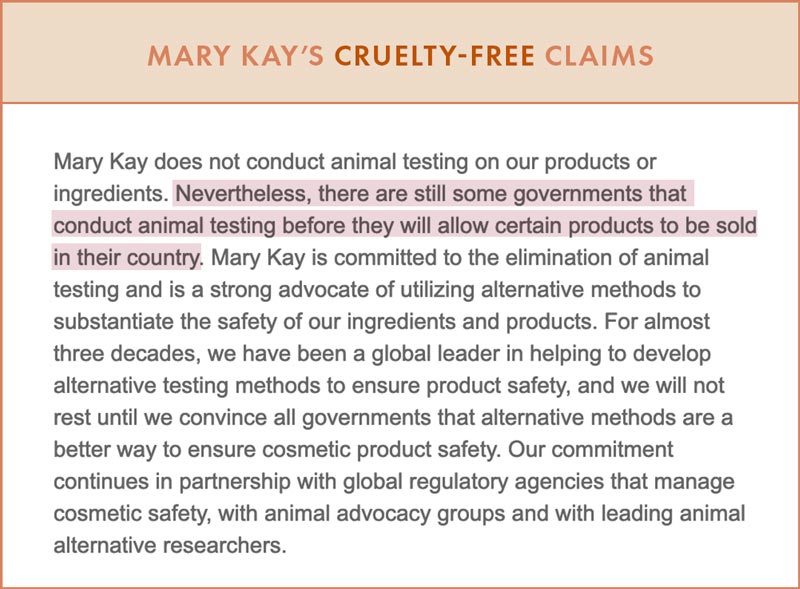In recent years, consumer awareness regarding animal welfare has surged, leading many to scrutinize the practices of beauty brands claiming to be cruelty-free. Among these brands is Mary Kay, a household name in cosmetics and skincare. The question arises: Is Mary Kay truly committed to being animal cruelty-free, or is it merely playing to the environmentally conscious consumer through greenwashing tactics?
To tackle this inquiry, it is essential first to define what being “cruelty-free” entails. The term typically signifies that a company does not engage in animal testing during the development of its products. However, the nuances of this definition can vary significantly. For instance, some companies may assert their cruelty-free status while still participating in or supporting animal testing via third-party suppliers or in collectivities mandated by law—especially in countries where such testing remains a legal requirement for cosmetic products.
Mary Kay has long marketed itself as a brand that adheres to ethical practices. They have implemented a policy of not testing their products on animals and have sought certification from organizations promoting cruelty-free standards. This stance paints a positive picture, eliciting admiration from consumers who prioritize ethical shopping. However, this narrative warrants deeper exploration.
One substantial aspect to consider is Mary Kay’s operations in international markets. In various regions, particularly in China, products are subject to mandatory animal testing. Despite their declarations of being cruelty-free, Mary Kay has continued to sell items within this jurisdiction. This raises pertinent questions about the integrity of their claims: Does a brand truly adhere to a cruelty-free ethos if it is implicated in a system that necessitates animal testing for market entry?
The reality is that many beauty brands, including Mary Kay, face a dilemma when it comes to expanding into certain markets. While they may offer vegan, cruelty-free products, the obligations imposed by regulatory frameworks compel them to comply with testing norms that blatantly contradict their stated values. This paradox can lead to the perception of greenwashing—wherein the company decorates its brand with a faux ethical veneer, while underneath lies a compliant adherence to exploitative practices.
Moreover, the dimensions of transparency are crucial in evaluating Mary Kay’s claims. A truly cruelty-free company will provide clear and unequivocal documentation of its animal testing policies, outlining specific measures undertaken to ensure ethical production. Mary Kay, while advertising its cruelty-free stance, has been criticized for a lack of transparency regarding its supply chain and third-party testing policies. Such opacity may lead consumers to question the authenticity of their commitment and raises suspicions about subsequent claims of ethical responsibility. Transparency is instrumental in a consumer’s ability to make informed decisions, and without it, the integrity of a brand’s ethical positioning is called into question.
Accusations of greenwashing often lead to discussions surrounding the marketing strategies employed by companies like Mary Kay, aimed squarely at appealing to a generation increasingly concerned with sustainability and ethical consumption. Companies that make lofty claims about their commitment to cruelty-free practices without substantial proof may inadvertently alienate the very consumer base they are courting. The consumers, once aware of such discrepancies, become ardent advocates for change, demanding accountability and reevaluation of brand ethics.
One avenue consumers can explore is the practice of researching certifications from recognized organizations. Many organizations offer third-party verification of cruelty-free claims, such as Leaping Bunny and PETA (People for the Ethical Treatment of Animals). A brand’s alignment with these organizations and their standards can provide a level of reassurance regarding its authenticity. Consumers are encouraged to assess whether Mary Kay has sought collaborations or certifications with such organizations and whether they are consistently upheld across their product lines.
Additionally, the rise of alternative brands centered around vegan and cruelty-free principles offers consumers a plethora of options that prioritize ethical standards above mere profit. Brands that have firmly committed to eliminating animal testing during the entirety of their supply chains provide tangible evidence of their dedication to animal welfare. The deliberate choice to support such enterprises over those that may be embroiled in grey areas can send a powerful message to larger corporations, urging them to reevaluate their business practices or risk losing market share.
Ultimately, when dissecting whether Mary Kay can rightfully claim a cruelty-free label, it is necessary to weigh their marketing assertions against their operational realities. A commitment to ethical standards should be consistent, transparent, and devoid of implications of compromise. The needs of consumers continue to evolve, and as advocates for animal welfare, it is crucial to remain vigilant. Awareness and advocacy can propel change not only in individual companies but throughout the entire industry.
In conclusion, while Mary Kay has made strides in marketing itself as a cruelty-free brand, the realities of compliance with international regulations and a lack of thorough transparency pose significant doubts about its authenticity. Consumers must remain informed and scrutinize the claims made by such companies, pushing for greater accountability and redefining what it truly means to be cruelty-free. The advocacy for animal welfare in beauty products is not just about selecting names from store shelves; it is about championing inherent ethical standards that align with deeply held values regarding the humane treatment of all living beings.








